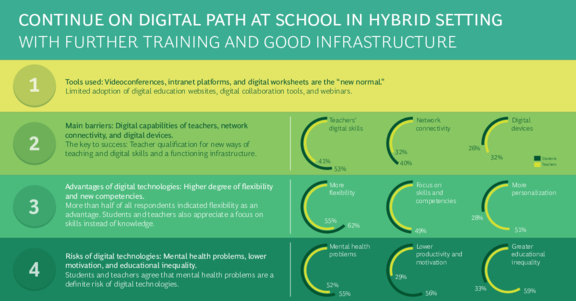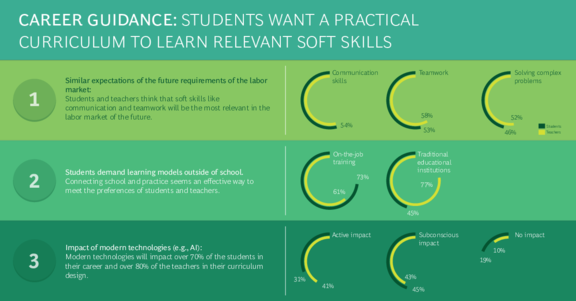Flexible, hybrid, and practically oriented: How young people and teachers see the schools of the future
Teachers need better digital skills
The digital tools most frequently used at schools are videoconferences, school-specific intranets/learning and work platforms, online exercises, and educational videos. However, easy-to-use possibilities like educational websites, digital collaboration tools, and webinars are less common at schools. Since March 2020, thanks to the dedication of teachers, major progress has been made at schools in terms of digitalization. But there is still plenty of room for improvement. Fifty-three percent of the students and 41% of the teachers surveyed believe that teachers’ lack of digital skills is the main roadblock to further progress. The surveyed teachers thus have a remarkably clear-eyed view of their own expertise—or lack of it. “Training teachers in digital learning could be an effective way to strengthen their skills and accelerate digitalization at schools,” says Dr. Babette Claas, head of the educational initiative business@school, adding, “One thing is clear: There’s no going back, and the digitalization of schools must continue.” Even though most schools now have the required hardware, at least in part, there are still gaps: Both the students and teachers participating in the survey (40% and 32%, respectively) cited the lack of network connectivity and smart devices (26% and 32%) as major hurdles.
More flexibility but also a higher mental toll
The advantages of digital technologies for both groups are obvious: They appreciate their flexibility (62% of surveyed students and 55% of surveyed teachers), along with the opportunity to focus on modern skills and competencies rather than pure book learning (as 49% in both groups responded). Asked about the risks, the surveyed students (55%) and teachers (52%) agreed that digitalization takes a toll on mental health, for reasons such as isolation—a view that may be a result of the prolonged restrictions on schools and personal life that were still in effect at the time of the survey. Beyond this, 59% of surveyed teachers warned of deepening inequalities in education, while 56% of surveyed students expressed concern about lower productivity and motivation.
Hybrid instruction is the future
The survey respondents agreed: Rather than returning to how things were before, i.e., physical classroom instruction alone, schools should teach subjects with a combination of online and physical instruction, especially in higher grades. Sixty-one percent of the students and 78% of the teachers were in favor of such a hybrid model.
Practical skills for better career orientation
Both groups had similar responses to the question of which skills will be the most relevant on the job market: communication and teamwork skills, along with critical thinking and the ability to solve complex problems. To acquire these skills, 73% of the surveyed students and 61% of the teachers believe that on-the-job training, like internships, is particularly effective. Only 45% of the surveyed students, but 77% of the teachers view traditional educational institutions like schools and universities as suitable for teaching the skills above. “Collaboration with outside, practically oriented partners can be a success factor in bridging the gap between today’s more theoretical learning and the practical skills that will be required on the job market of tomorrow—skills that students will need in a dynamic employment environment,” noted Dr. Alexander Türpitz, Managing Director and Senior Partner at BCG and leader of the practice area Public Sector in Germany.
The jobs of the future
What makes a good job? For the surveyed students, the work has to be interesting (63%) and fairly compensated (47%), with career development opportunities and a good work-life balance (45% each). Good relations with colleagues and superiors, along with training opportunities, were seen as being less important by the students. When it comes to the impact that the increasing use of modern technologies will have on their careers, students have their eyes wide open: 76% say they are taking the influence of technology megatrends such as automation and artificial intelligence (AI) into account in planning their careers.
1 Over 90% of the students surveyed are age 16–18, 60% male and 40% female; 87% attend school in Germany, other students come from Austria (6%), Italy (4%), Switzerland (2%), and Albania (1%).
2 For the teachers, the age groups 30–39 and 50–59 are the most represented at 30% each; 3% are over 60, 51% are female and 49% male.




